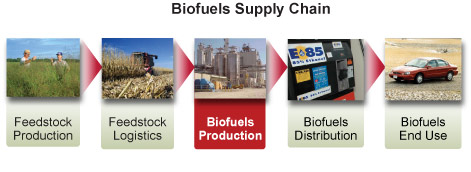Integrated Biorefineries
Biorefineries are similar to petroleum refineries in concept; however, biorefineries use biological matter (as opposed to petroleum or other fossil sources) to produce transportation fuels, chemicals, and heat and power.

Integrated biorefineries employ various combinations of feedstocks and conversion technologies to produce a variety of products, with the main focus on producing biofuels. Side products can include chemicals (or other materials) and heat and power. The renewable feedstocks utilized in integrated biorefineries include, but are not limited to: grain such as corn, wheat sorghum, and barley; energy crops such as switchgrass, miscanthus, willow and poplar; and agricultural, forest, and industrial residues such as bagasse, stover, straws, forest thinnings, sawdust and paper mill waste.
The benefits of an integrated biorefinery are numerous because of the diversification in feedstocks and products. There are currently several different levels of integration in biorefineries which adds to their sustainability, both economically and environmentally. For example, some biorefinery concepts solely produce ethanol or biodiesel, whereas other concepts fully incorporate livestock farming or heat and power and other biobased products. Most of these refineries are nearly self-sustaining in respect to energy consumption. Continued developments in the areas of feedstocks, and conversion processes (both biochemical and thermochemical) enable more economical and environmentally sustainable options for integrated biorefineries. This also allows for biorefineries to spread into a wider geographical region of the United States.
Economic and production advantages increase with the level of integration in the biorefinery. This is why the Biomass Program is focused on developing and deploying technologies that can be bundled to enable and define integrated biorefinery facilities.
Integrated Biorefineries Related Links















